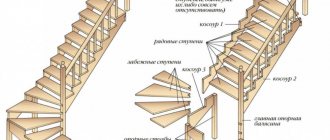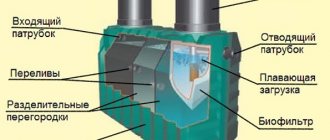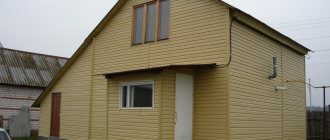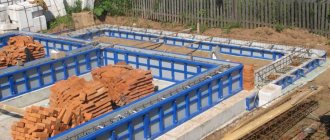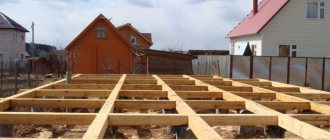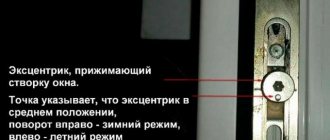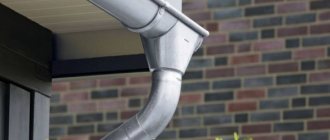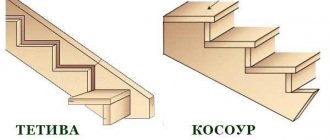Today, even in summer country houses, many try to install at least a minimum set of plumbing fixtures. All the more understandable is the desire of the owners to equip a house intended for permanent residence as comfortably as possible. One of the most convenient ways to organize local sewerage is to install a ready-made industrial septic tank, for example, a Tank. Let's look at the instructions and basic recommendations for installing this installation.
Outdoor toilets and showers, which were previously indispensable attributes of country life, are becoming a thing of the past. Even if the village does not have a central sewer system, it is quite possible to equip autonomous wastewater treatment plants.
Autonomous installations - septic tanks - are used to collect and process wastewater. In them, wastewater settles and undergoes several stages of biological treatment. One of the most popular models of treatment plants is the septic tank Tank.
Installing a septic tank with your own hands, correct installation of the Universal, Bio and other models
Initially, you need to select a location to install the cleaning system. This requires the following conditions to be met:
- the lowest possible groundwater level;
- the distance from a residential building should not be less than 5 m;
- It is necessary to ensure unimpeded access for sewage disposal equipment to the septic tank.
Compliance with these conditions guarantees long-term and trouble-free operation of the installed equipment for 50 years.
Installation of a septic tank Tank is no different from installations of other septic tanks
Do-it-yourself installation of a septic tank Tank includes the following work:
- digging a pit. The pit needs to be dug with dimensions exceeding the dimensions of the structure by 25-30 cm. When calculating the depth, the height of the sand cushion is taken into account, the optimal height of which is 30 cm;
- laying sand at the bottom of the pit - this allows it to be leveled;
- it is necessary to equip a trench through which sewer pipes will pass;
- lowering equipment into the pit. Before installing a septic tank Tank, it is necessary to check the integrity of the tank;
- connect sewer pipes;
- backfilling of equipment located in the pit. Every 30 cm of soil must be compacted. In order to balance the pressure on the walls of the container, you need to fill it layer by layer with water;
- filling the septic tank completely with water - it should be 30-35 cm higher than the backfill level;
- insulation of the upper part of the treatment plant. The container is covered with insulation, after which the neck is filled.
Installation of infiltrators: secrets of the manufacturer
The antiseptic tank for the dacha is ready for use. If you need to install infiltrators, the work order is as follows:
- we measure 1 m from the cleaning system - at this distance it is necessary to dig a pit to equip the infiltrator;
- geotextile is laid on the sides of the pit, and a layer of crushed stone is poured onto the bottom - its height is 40 - 50 cm;
- an infiltrator is installed on top of the crushed stone cushion;
- the pipes coming from the septic tank are connected - water will flow through them;
- a ventilation riser is installed at the outlet;
- The infiltrator is backfilled with a sand mixture; the top of the equipment must be covered with isolon as an insulating layer. You need at least 3 layers of isolon.
To properly install a septic tank with your own hands, it is necessary to install it in accordance with technical requirements. The main difficulty is leveling the equipment when placed in a pit, as well as backfilling the device. During these operations, errors are usually made, resulting in damage to the equipment casing. This nullifies all efforts, since untreated wastewater begins to penetrate into the soil, and an unpleasant odor appears, which should not exist if the installation is of proper quality.
There are also difficulties when installing a pipe system - the pipes must run with slight slopes towards the drain. If you are not confident in your abilities, it is better to entrust the installation of a septic tank to specialists. Septic Tank is an excellent option for country sewerage!
Rules for installing a septic tank and infiltrator
The first step is determining the location for the septic tank and marking it, taking into account that the hole should be wider than the container by about 30 cm on each side. The depth of the pit is determined to completely cover the height of the tank and provide 30-50 cm per cushion. If the groundwater in the area is high, then the sand cushion must be covered with concrete slabs or a concrete screed made.
Before purchasing and installing, you must carefully check the tank body for its integrity. When the pit for the septic tank is ready, you need to dig trenches for laying the sewer pipes of the house to the septic tank and from the septic tank to the infiltrator. During the process, it is imperative to ensure that a slope of 2-3 cm for each meter of the pipeline. Otherwise, the wastewater will not be able to move through the system by gravity.
You can lower the tank into the pit using special equipment or manually (with several assistants). It is important that no distortions occur during installation. Immediately after installing the container in the pit, a pipeline is installed from the house to the septic tank and from the septic tank to the infiltrator and their connection is made.
To backfill, you need to make a cement-sand mixture with a material ratio of 1×5. 20−30 cm of the mixture is poured, it is compacted, another 20−30 cm is poured, etc. To avoid skewing the container, simultaneously with filling it, it is necessary to gradually fill it with water. The water level should always be approximately 20 cm above the backfill level. This will prevent deformation and rupture of the plastic. It is not recommended to use equipment for backfilling - the container may be damaged.
To install the infiltrator at a distance of 1-1.5 m from the septic tank, it is necessary to dig a rectangular pit. Geotextiles are laid at its bottom and crushed stone is poured. The crushed stone layer is 40 centimeters or more. The infiltrator is placed on a bed of crushed stone and connected to the main reservoir. A ventilation riser is mounted on the other side of the infiltrator. This container is filled with sand.
Insulation is placed on the upper part of the body of the septic tank and infiltrator and backfilled. Some believe that the septic tank should be disguised so as not to spoil the appearance of the site. When camouflaging, it is necessary to take into account that trees cannot be planted for this purpose - their roots can damage the plastic casing. It is also necessary to ensure that vehicles do not drive over either the main tank or the infiltrator.
A few words about Tank septic tanks
“Tank” septic tanks are made of high-strength plastic; the body is reinforced with additional stiffening ribs, which ensure the reliability of the structure.
Externally, the equipment looks monolithic, but it is a multi-chamber cleaning system, where sewage waste goes through several stages of processing. The liquid first settles, then fractional separation occurs when solid particles settle to the bottom, and the rest of the mass flows into a compartment populated by microorganisms. As a result, the drain is cleaned by 75%; to increase this figure, infiltrators are installed that perform the function of a soil filter for post-treatment.
The advantages of the product are reliability, performance, durability and relatively low cost.
Features of installation of a treatment plant
Installing a septic tank yourself is quite easy. However, there are individual features of equipment installation. They must be taken into account when designing an autonomous sewer system for a private home. These nuances include:
- distance to a residential building, water source, green spaces;
- type of soil;
- ground water level;
- landscape of the territory.
When installing a cleaning system, it is necessary to comply with general sanitary standards and building regulations reflected in the relevant documents. To achieve 100% recycling of wastewater, soil post-treatment is used. This process is carried out by passing 75% purified wastewater in a septic tank through a layer of crushed stone. Due to this installation feature, the following common installation schemes exist:
- Installation of a septic tank with drainage pipes. This is a classic version of the wiring diagram. It is used when the soil on the site is characterized by normal absorption. When implementing this option, a filtration field is installed on private territory. Its area must be at least 30 m2. Therefore, filtration fields are arranged exclusively in large areas.
- Installation of a septic tank with an infiltrator. This is an alternative to drainage pipes. Such an installation scheme can be implemented in a small area. In most cases, together with the “Tank” septic tank, an infiltrator with the same volume as the local treatment tank is installed. For example, if you are installing Triton 400, which is a tank without a bottom with a capacity of 400 liters, then there is no need to lay drainage pipes approximately 36 m long.
- Installation of a septic tank with a filtration well. This installation scheme is usually used on sandy soils with low water levels in the soil. In some cases, a filtration well can fully replace the filtration field. Its arrangement makes it possible to significantly reduce the area of the treatment system.
- Construction of a septic tank with an infiltration tank and an intermediate well, which is created in areas with high groundwater. Wastewater purified to 75% is moved by gravity into the well. Then, using a pumping unit with a float, they are pumped into the infiltrator. From the tank, wastewater is gradually absorbed into the soil.
Important! When installing the Tank septic tank, you must strictly follow the installation rules reflected in the official instructions.
It is more convenient to install a local treatment tank yourself with an industrially manufactured infiltrator. The use of structures without a bottom on the site allows you to quickly install an autonomous sewer system. The design feature of the infiltrator is strong walls with stiffening ribs. An outlet pipe is located at the end of the oblong tank. It is used to connect a ventilation pipe or the required number of other similar modules. You can also use a septic tank model without an outlet pipe on the site. This version of the device is equipped with a hole for ventilation in the upper part. In addition, there is also an inlet pipe at the end of the tank. It is used to connect the container to the “Tank” septic tank.
Filtration of wastewater is carried out through a special layer, which consists of sand and crushed stone. It is on such a pillow that the container is mounted. The filter layer allows you to remove remaining contaminant particles from the wastewater. Impurities settle on it, and purified water enters the soil. It can even be used for technical needs.
Design and operating principle
A septic tank looks like a large plastic cube with a ribbed surface and a neck (or two) protruding above the surface. Inside, it is divided into three compartments in which wastewater is purified.
The body of this septic tank is entirely cast and has no seams. There are seams only at the neck connection. This seam is welded, almost monolithic - 96%.
Septic tank: appearance
Although the case is plastic, it is definitely not fragile - the decent thickness of the walls (10 mm) and additional even thicker ribs (17 mm) add strength. What is interesting is that when installing a septic tank, the Tank does not require a slab or anchoring. Moreover, even with a high groundwater level, this installation does not float, but this is subject to installation requirements (more about them below).
Another design feature is the modular structure. That is, if you already have such an installation and find that its volume is not enough for you, simply install another section next to it and connect it to the one already working.
The modular structure allows you to increase the capacity of the septic tank Tank at any time
Principle of operation
A septic tank works the same way as many other similar installations. The procedure for treating wastewater is as follows:
- The water draining from the house ends up in the receiving compartment. It has the largest volume. While it is filling, the waste decomposes and ferments. The process is carried out with the help of bacteria, which are contained in the waste itself, and good conditions for their life are simply created in the tank. During the cleaning process, solid sediments fall to the bottom, where they are gradually compressed. Lighter, fat-containing dirt particles rise upward, forming a film on the surface. The more or less clean water located in the middle part (purification at this stage is approximately 40%) enters the second chamber through the overflow hole.
- In the second compartment the process continues. The result is another 15-20% cleansing.
- The third chamber has a biofilter in the upper part. It purifies wastewater up to 75%. Through the overflow hole, water is removed from the septic tank for further purification (into the filter column, onto the filtration fields - depending on the type of soil and groundwater level).
Not a bad way out
As you can see, there are no difficulties. With proper installation and operation, the Tank septic tank works flawlessly - it does not depend on electricity, so it is not afraid of frequent power outages in rural areas. The installation also withstands uneven schedules of use, which is typical for dachas. In this case, the flow of wastewater on weekdays is usually minimal or absent, and on weekends it reaches a maximum. This work schedule does not affect the cleaning result in any way.
The only thing that is necessary for dachas is conservation for the winter, if living is not planned. To do this, you need to pump out the sludge, fill all containers 2/3 with water, and insulate the top well (fill with leaves, tops, etc.). In this form you can leave it over the winter.
Features of operation
Like any septic tank, the Tank reacts poorly to large amounts of active chemicals - a one-time supply of a large amount of water with bleach or a chlorine-containing preparation kills bacteria. Accordingly, the quality of cleaning deteriorates, and an odor may appear (during normal operation there is none). The solution is to wait until the bacteria multiply or forcefully add them (bacteria for septic tanks are commercially available).
| Name | Dimensions (L*W*H) | How much can clear | Volume | Weight | Price of septic tank Tank | Installation price |
| Septic Tank - 1 (no more than 3 people). | 1200*1000*1700 mm | 600 liters/day | 1200 liters | 85 kg | 330-530 $ | from 250 $ |
| Septic Tank - 2 (for 3-4 people). | 1800*1200*1700 mm | 800 liters/day | 2000 liters | 130 kg | 460-760 $ | from 350 $ |
| Septic Tank - 2.5 (for 4-5 people) | 2030*1200*1850 mm | 1000 liters/day | 2500 liters | 140 kg | 540-880 $ | from 410 $ |
| Septic Tank – 3 (for 5-6 people) | 2200*1200*2000 mm | 1200 liters/day | 3000 liters | 150 kg | 630-1060 $ | from 430 $ |
| Septic Tank – 4 (for 7-9 people) | 3800*1000*1700 mm | 600 liters/day | 1800 liters | 225 kg | 890-1375 $ | from 570 $ |
| Infiltrator 400 | 1800*800*400 mm | 400 liters | 15 kg | 70 $ | from 150 $ | |
| Cover D 510 | 32 $ | |||||
| Extension neck D 500 | height 500 mm | 45 $ | ||||
| Well for pump D 500 | height 600 mm | 120 $ | ||||
| Well for pump D 500 | height 1100 mm | 170 $ | ||||
| Well for pump D 500 | height 1600 mm | 215 $ | ||||
| Well for pump D 500 | height 2100 mm | 260$ |
Another feature that must be taken into account is not to flush waste that cannot be decomposed by bacteria down the drain. As a rule, this is waste that appears during repairs. Not only can they clog the drain, and you will have to clean it, but these particles also significantly increase the amount of sludge, and the septic tank tank will have to be cleaned more often.
Device and principle of operation
Traditionally, in the private sector, a drain well or pit without a bottom is installed. However, this method is unacceptable given the modern standard of living with the frequent use of chemical detergents. The ecosystem of the site and the entire surrounding area is suffering. An unpleasant odor is a common drawback of such a structure.
Installing a sealed storage tank will only help with periodic living. Otherwise, the costs of vacuum cleaner services, especially if there is a shower and washing machine in the house, become significant.
A septic tank is a local structure that is dug into the ground on its own site. In essence, it is an underground settling tank in which first mechanical and then biological purification of wastewater occurs.
After a septic tank, the degree of water purification reaches 75%, so it is imperative to install an additional additional treatment device - a filtration field, an infiltrator, a filtration well
When combining a septic tank and a ground filtration device, a degree of water purification equal to 96-98% is achieved.
A septic tank is a cast container made of polypropylene, the internal volume of which is divided into three sections. The chambers are connected to each other by internal overflows, the latter is equipped with a powerful eco-filtration system.
The body of the device is lightweight and durable at the same time. Thick, elastic, ribbed walls withstand soil pressure without deforming. There are service hatches in the upper part. The design of the Tank is block-modular, which allows you to obtain any required volume of water disposal by connecting several devices in series.
A septic tank is selected depending on the daily volume of water consumption. All Tank models are quite compact and can be mounted almost anywhere on the site
Each chamber of the septic tank performs a specific task. The first is the receiving area - all wastewater from the house enters it and undergoes primary treatment. As a result of settling, heavy particles sink to the bottom and form a layer of sludge, while light fatty and organic fractions float to the top.
The next section receives conditionally pure water from the middle region. Here the process is similar - additional settling occurs.
In the last chamber, the liquid passes through a floating module - a filter made of polymer fibers, in which colonies of anaerobic bacteria settle. Under their influence, waste decomposes, and the remnants of the process settle on the bottom.
The manufacturer recommends cleaning the septic tank chambers from sludge once a year.
The operation of the septic tank Tank does not depend on the availability of electricity and occurs in a completely autonomous mode
To completely purify the water, the system must be supplemented with a soil purification device. Since the installation of a septic tank Tank is most often done by hand, the most convenient structures are industrially manufactured infiltrators. They allow you to organize a wastewater treatment system in the shortest possible time and do not require complex installation.
Structurally, the infiltrator is an oblong tank with ribbed strong walls and no bottom. Outwardly, it resembles a lid. At the ends there are nozzles - inlet and outlet.
The output is used to connect several modules in series or to output a ventilation pipe. There are models without an outlet pipe - they have a ventilation hole in the upper part of the body.
The use of an infiltrator in an autonomous sewer system can significantly increase the degree of wastewater treatment. The shape of the device body promotes the direction of wastewater only downwards (+)
The filter layer is a cushion of sand and crushed stone or gravel, on which the body of the device is installed. Passing through such a purifying natural filter, all undecomposed impurities and substances remaining in the water settle, and water enters the ground, comparable in purity to technical water.
Description
Schematic of a septic tank
Septic tank and septic drain field
A septic tank consists of one or more concrete or plastic tanks of between 4000 and 7500 liters (1,000 and 2,000 gallons); one end is connected to an inlet wastewater pipe and the other to a septic drain field. Generally these pipe connections are made with a T pipe, allowing liquid to enter and exit without disturbing any crust on the surface. Today, the design of the tank usually incorporates two chambers, each equipped with a manhole cover, and separated by a dividing wall with openings located about midway between the floor and roof of the tank.
Wastewater enters the first chamber of the tank, allowing solids to settle and scum to float. The settled solids are anaerobically digested, reducing the volume of solids. The liquid component flows through the dividing wall into the second chamber, where further settlement takes place. The excess liquid, now in a relatively clear condition, then drains from the outlet into the septic drain field, also referred to as a leach field, drain field or seepage field, depending upon locality. A percolation test is required prior to installation to ensure the porosity of the soil is adequate to serve as a drain field.
The remaining impurities are trapped and eliminated in the soil, with the excess water eliminated through percolation into the soil, through evaporation, and by uptake through the root system of plants and eventual transpiration or entering groundwater or surface water. A piping network, often laid in a stone-filled trench (see weeping tile), distributes the wastewater throughout the field with multiple drainage holes in the network. The size of the drain field is proportional to the volume of wastewater and inversely proportional to the porosity of the drainage field. The entire septic system can operate by gravity alone or, where topographic considerations require, with inclusion of a lift pump. Certain septic tank designs include siphons or other devices to increase the volume and velocity of outflow to the drainage field. These help to fill the drainage pipe more evenly and extend the drainage field life by preventing premature clogging or bioclogging.
An Imhoff tank is a two-stage septic system where the sludge is digested in a separate tank. This avoids mixing digested sludge with incoming sewage. Also, some septic tank designs have a second stage where the effluent from the anaerobic first stage is aerated before it drains into the seepage field.
A properly designed and normally operating septic system is odor-free and, besides periodic inspection and emptying of the septic tank, should last for decades with minimal maintenance.
A well designed and maintained concrete, fiberglass, or plastic tank should last about 50 years.
Step-by-step installation of a septic tank Tank
Installation of a septic tank Tank cannot be called difficult. The main thing is to dig a pit for a septic tank and post-treatment devices, as well as trenches for pipes connecting all this and the house into one system.
The depth of installation of the septic tank Tank is determined by the depth of freezing. If it is no more than 1.50-1.70 cm, the septic tank is taken as standard. If the ground freezes 2 meters or more, an additional neck is used, and accordingly, the installation depth increases.
The pit is dug to such a depth that only the lid remains above the ground + 3-5 cm of sand bedding to level the bottom. The dimensions of the pit should be 25 cm or more larger than the dimensions of the septic tank.
Diagram with dimensions of installation of a septic tank Tank
Installation of a septic tank Tank with photo
Next, step by step:
- We are digging a pit. This can be done manually or using technology. We level the bottom, pour sand in a layer of 3-5 cm, compact it, level it.
Level the bottom of the pit with sand
- We lower the body. It is convenient to do this on ropes, passing them into the spaces between the ribs.
- We check whether the septic tank is level (with a building level laid on the neck covers).
- We connect the waste pipe from the house to the inlet pipe, which is located on the upper surface of the housing. We also lay the pipe to the after-treatment units or to the intermediate well (depending on the chosen scheme). It is better to use polyethylene pipes for outdoor work (red color). They can withstand negative temperatures and withstand loads normally.
We put a fitting on the inlet pipe and connect the pipe coming from the house to it
- We begin to pour water into the body.
- When the level in the tank rises by about 20 cm, we begin to fill the gap between the walls of the pit and the body of the septic tank. For backfilling we use a sand-cement mixture: for 1 part cement we take 5 parts sand. It is necessary to fill the perimeter manually, without the use of machinery. Having filled 20 cm, the layer is compacted with a hand tamper, taking care not to damage the body. During backfilling, the water level in the septic tank should be 20-30 cm above the sand layer. This guarantees the correct position of the walls during operation.
Fill with sand-cement mixture
- Having filled the walls to the top of the body, pour about another 15 cm of the mixture, level it and compact it.
- Lay a layer of insulation. The best option is extruded polystyrene foam (EPS), you can also use isofol. The use of polystyrene foam is undesirable - it can flatten under soil loads and stop working. You cannot use mineral wool at all - it is hygroscopic and after a while it will simply crumble into dust. The insulation layer depends on the region and the type of material used. For example, EPPS for Central Russia requires 5 cm, for the northern regions - 10 cm.
EPS laid
- We fill the “native” soil on top of the insulation. The height of the backfill is level with the ground level.
This is all. Septic tank installed. There are a few more points regarding the creation of a sewer system. It makes sense to insulate the sewer pipe that comes from the house. In regions with not very cold winters, it is enough to lay EPS on top (it should cover the pipe and protrude 7-10 cm along the edges). You can simply cover it with soil.
It is advisable to insulate the pipeline. Then you will be sure that it will not freeze in winter
In northern regions, only insulation on the pipe may not be enough. In addition to this, the pipes are heated using heating cables for water and sewer pipes. To make heating more efficient, it is laid not outside, but inside the pipe. Only the shell must be resistant to aggressive environments.
Installation of the infiltrator
One of the components of an individual sewerage system using a Tank septic tank is an infiltrator. This is a device for post-treatment of wastewater leaving a septic tank. It is a plastic container made in the form of a trapezoid, in the walls and bottom of which there are many slot-type holes.
What is an infiltrator and how does it work
Relatively small in size - 1800*800*400 mm, it holds up to 400 liters of liquid. It is laid on a crushed stone cushion with a height of 40 cm. This height of a layer of crushed stone is necessary on soils with a normal ability to drain water; on poorly drained soils it can be 70 cm or more.
The number of required infiltrators depends on the magnitude of the salvo discharge, as well as on the characteristics of the soil. With the same installation power, sandy, well-draining soils require fewer additional purification elements than soils with average or poor drainage ability.
Installation diagram of an infiltrator for a septic tank Tank
The procedure for installing an infiltrator for final wastewater treatment is as follows:
- We are digging a pit, which is 500 mm larger in size than the finfiltrator.
- We line the bottom and walls with geotextiles. It is needed to ensure that the crushed stone does not mix with the soil.
- Pour and level a layer of crushed stone.
Crushed stone is poured
- We lay the infiltrator body.
- We connect it to the outlet of the septic tank.
- We install the ventilation pipe.
We lay it in the foundation pit
- We fill it with sand so that it covers the body from above by 15 cm.
- We lay a layer of insulation (can be the same as on the body of the Tank septic tank).
- We fill it with soil.
When installing the infiltrator, there is no need to use a mixture of sand and cement, since the body rests on a crushed stone cushion, which successfully compensates for all movements.
The best posts
- Original partitions in the apartment
- Master class on a DIY nativity scene made from salt dough and paper
- DIY autumn crafts for children
- Do-it-yourself interior door repair (photo and video)
- New Year's costume "Rainbow Dash"
- How to properly sand a wooden floor with your own hands
- How to increase water pressure in a water supply? Three ways
- Thickness of plywood on a wooden floor: laying the underlay, how to lay it without glue, flooring in the house, how to lay the covering
Related article: The most reliable storage water heaters
Pros and cons of septic tank Tank
The septic tanks in question can be installed on the site at any time of the year. Problems will arise only with digging frozen ground. You can choose a place for the “Tank” right next to the house at a distance of 2–3 meters from it
It doesn’t matter whether a strip or column foundation is used to build housing, moisture from the sealed housing will not seep into the ground and affect the concrete
But the infiltrator should be removed from the base of the building, on the contrary, further away. The humidity around it is always high. If you place it next to a residential building, then even precipitation-resistant facade plaster from the walls of the house will sooner or later begin to fall off.
The effluent in the anaerobic VOC "Tank" is treated only up to 80%. Without the use of an infiltrator, such water cannot be discharged into a reservoir or used for watering beds. In this regard, this septic tank is somewhat inferior to competitors of the same factory design.
Basic rules of use
In order for a self-installed septic tank to serve for a long time, you must adhere to the rules for its use:
- It is necessary to regularly (usually once a year) clean the septic tank from accumulated solid waste. If waste is not pumped out in time, the sediment will become very dense, which will negatively affect the operation of the sewer system. After pumping out the contents of the septic tank, it must be immediately filled with water.
- To improve the quality of wastewater treatment, it is recommended to use special biological products for septic tanks. The use of such products reduces the amount of solid waste and allows you to use vacuum cleaners less often.
- Another reason affecting the quality of work is the discharge of large amounts of disinfectants into the sewer system, which lead to the death of biomaterial.
When planning to install a Tank brand septic tank, it is worth getting acquainted with the installation installation rules. If you wish, you can watch the process in a video that shows the main points of the work.
Environmental concerns
A septic tank before installation, with manhole cover on top
The same tank partially installed in the ground
While a properly maintained and located septic tank does not pose any more environmental problems than centralized municipal sewage treatment[ citation needed
], certain problems could arise with a septic tank in an unsuitable location. Since septic systems require large drainfields, they are unsuitable for densely built areas.
Odor and gas emissions
Some constituents of wastewater, especially sulfates, under the anaerobic conditions of septic tanks, are reduced to hydrogen sulfide, a pungent and toxic gas. Methane may also be released. Nitrates and organic nitrogen compounds can be reduced to ammonia. Because of the anaerobic conditions, fermentation processes take place, which may generate carbon dioxide and/or methane.[ citation needed
]
Nutrients in the effluent
Septic tanks by themselves are ineffective at removing nitrogen compounds that have potential to cause algal blooms in waterways into which affected water from a septic system finds its way. This can be remedied by using a nitrogen-reducing technology, or by simply ensuring that the leach field is properly sited to prevent direct entry of effluent into bodies of water.[ citation needed
]
The fermentation processes cause the contents of a septic tank to be anaerobic with a low redox potential, which keeps phosphates in a soluble and, thus, mobilized form. Phosphates discharged from a septic tank into the environment can trigger prolific plant growth including algal blooms, which can also include blooms of potentially toxic cyanobacteria.
The soil's capacity to retain phosphorus is usually large enough to handle the load through a normal residential septic tank. An exception occurs when septic drain fields are located in sandy or coarser soils on property adjacent to a water body. Because of limited particle surface area, these soils can become saturated with phosphates. Phosphates will progress beyond the treatment area, posing a threat of eutrophication to surface waters.
Groundwater pollution
In areas with high population density, groundwater pollution beyond acceptable limits may occur. Some small towns experience the costs of building very expensive centralized wastewater treatment systems because of this problem, due to the high cost of extended collection systems. To reduce residential development that might increase the demand to construct an expensive centralized sewerage system, building moratoriums and limitations on the subdivision of property are often imposed. Ensuring existing septic tanks are functioning properly can also be helpful for a limited time, but becomes less effective as a primary remediation strategy as population density increases.
Surface water pollution
In areas adjacent to water bodies with fish or shellfish intended for human consumption, improperly maintained and failing septic systems contribute to pollution levels that can force harvest restrictions and/or commercial or recreational harvest closures.
Product range of Triton Plastic LLC
The range of manufactured products is very wide. It includes treatment systems and peat dry closets, water tanks and grease traps for washing, caissons for wells and deep cleaning stations.
Product range
The product range consists of several modifications, differing in size, volume and daily productivity. These are products marked: from 1 to 4.
In addition to this model, the company produces septic tanks of the following types:
- Tank station wagon
- Triton – T and Triton – N
- Microbe
Let's start with the smallest structure. The septic tank model Tank microbe is a series of miniature devices for use in guest houses or country houses, and can also be used as a reservoir for storm sewerage and installation in places of temporary residence. The body of the treatment plant of the Universal model is made of durable low-pressure polyethylene and can be operated at sub-zero temperatures.
Model Triton N
The Triton septic tank is available in two models: storage and three-chamber. Triton N is not a treatment facility, but is used only as a wastewater collection tank. A three-chamber septic tank has an operating principle that allows you to organize an autonomous sewage system in a country house.
It consists of three chambers inside which the wastewater treatment process takes place. Here, slowly flowing from one section to another, they are gradually cleaned and, as a result, suspended particles settle to the bottom. The station wagon series is a new series of products.
It is designed for use in suburban households and allows you to purchase missing sections if you need to increase the volume of wastewater. This Tank 3 model combines the best characteristics of products under the Tank brand with high technology and the ability to complete the required configuration.
general information
- The size of the septic tank is calculated based on SNiP 2.04.03-85.
According to statistics, one resident uses 200 liters of the main resource per day. Therefore, to find out what volume is optimal for a home, the number of people is multiplied by 200.- Let's say there are 3 people permanently living there. 3*200=600 l.
- But according to the rules, wastewater must remain in the septic tank for at least 14 days. Therefore, we multiply this value by another 3.
- 600*3=1800. Required septic tank volume 1.8 cubic meters
- In fact, the amount of water used is greatly exaggerated.
- Three people will spend from 300 to 450 liters per day.
- It is a mistake to think that purchasing a septic tank larger than required is a waste of money.
- The larger the volume, the higher the degree of wastewater treatment and the less load on the station, which increases its service life.
- And factors such as the arrival of guests should also be taken into account. Water consumption will increase.
Emptying
A vacuum truck used to empty septic tanks in Germany
Waste that is not decomposed by the anaerobic digestion must eventually be removed from the septic tank. Otherwise the septic tank fills up and wastewater containing undecomposed material discharges directly to the drainage field. Not only is this detrimental for the environment but, if the sludge overflows the septic tank into the leach field, it may clog the leach field piping or decrease the soil porosity itself, requiring expensive repairs.
When a septic tank is emptied, the accumulated sludge (, also known as ) is pumped out of the tank by a . How often the septic tank must be emptied depends on the volume of the tank relative to the input of solids, the amount of indigestible solids, and the ambient temperature (because anaerobic digestion occurs more efficiently at higher temperatures), as well as usage, system characteristics and the requirements of the relevant authority. Some health authorities require tanks to be emptied at prescribed intervals, while others leave it up to the decision of an inspector. Some systems require pumping every few years or sooner, while others may be able to go 10–20 years between pumpings. An older system with an undersize tank that is being used by a large family will require much more frequent pumping than a new system used by only a few people. Anaerobic decomposition is rapidly restarted when the tank is refilled.
Services for de-sludging tend to empty a septic tank completely, ie take out all septage, although the actual removal of settled solids is left purposefully incomplete, so as to leave at least some of the microbial populations in place to continue the anaerobic degradation processes that take place in a septic tank. An empty tank may be damaged by hydrostatic pressure causing the tank to partially “float” out of the ground, especially in flood situations or very wet ground conditions.
Description
Schematic of a septic tank
Septic tank and
A septic tank consists of one or more concrete or plastic tanks of between 4000 and 7500 liters (1,000 and 2,000 gallons); one end is connected to an inlet pipe and the other to a . Generally these pipe connections are made with a T pipe, allowing liquid to enter and exit without disturbing any crust on the surface. Today, the design of the tank usually incorporates two chambers, each equipped with a manhole cover, and separated by a dividing wall with openings located about midway between the floor and roof of the tank.
Wastewater enters the first chamber of the tank, allowing solids to settle and scum to float. The settled solids are anaerobically digested, reducing the volume of solids. The liquid component flows through the dividing wall into the second chamber, where further settlement takes place. The excess liquid, now in a relatively clear condition, then drains from the outlet into the , also referred to as a leach field, drain field or seepage field, depending upon locality. A is required prior to installation to ensure the porosity of the soil is adequate to serve as a drain field.
The remaining impurities are trapped and eliminated in the , with the excess water eliminated through into the soil, through , and by uptake through the system of and eventual or entering or . A piping network, often laid in a stone-filled trench (see ), distributes the wastewater throughout the field with multiple drainage holes in the network. The size of the drain field is proportional to the volume of wastewater and inversely proportional to the porosity of the drainage field. The entire septic system can operate by gravity alone or, where topographic considerations require, with inclusion of a lift. Certain septic tank designs include or other devices to increase the volume and velocity of outflow to the drainage field. These help to fill the drainage pipe more evenly and extend the drainage field life by preventing premature clogging or .
An is a two-stage septic system where the sludge is digested in a separate tank. This avoids mixing digested sludge with incoming sewage. Also, some septic tank designs have a second stage where the from the anaerobic first stage is aerated before it drains into the seepage field.
A properly designed and normally operating septic system is odor-free. Besides periodic inspection and emptying, a septic tank should last for decades with minimal maintenance, with concrete, fiberglass, or plastic tanks lasting about 50 years.
Why Tank
About the advantages of septic tanks Tank
If, when building a house, the question arises about choosing a suitable sewerage system, an autonomous sewerage system for a Tank dacha can be considered as a contender for this role, since it has a number of advantages compared to similar devices:
- The polypropylene ribbed cast body is highly durable, which ensures the septic tank can operate for a long time without damage.
- Installing a septic tank Tank is much faster than constructing the now traditional reinforced concrete rings or laying brick walls of a drainage pit.
- Combined purification of household wastewater using biological and chemical processes, as well as post-treatment using infiltrate, allows for particularly high-quality purification of waste water.
- Multi-stage cleaning allows you to increase the service life of the drainage system many times.
- The ability to carry out mandatory cleaning of the septic tank not every year, but once every 5-8 years.
Tank operation diagram
How do septic tanks work?
In terms of its design, the autonomous sewage system of a private Tank house, consisting of several sections, is quite clear and simple. Let's look at the principle of its operation:
- The pipe included in the first section directs into it all the drains discharged from residential and utility rooms. Here, mechanical separation of the solid phase from the liquid occurs: solid particles sink to the bottom, water accumulates above the sediment, and the fat present in the effluent collects on its surface.
- Water that has undergone primary clarification is transferred through an overflow pipeline system to the second section of the installation, where it is purified using chemical reagents.
- The third section of the septic tank is a biofilter, where the water undergoes biological treatment.
- Country sewerage Tank includes a filter platform located near the installation. After passing through three stages, water enters the infiltrator for post-treatment.
Autonomous sewerage sections Tank
Device
The “Tank” septic tank contains 3 chambers with pipes for wastewater inlet, purified liquid outlet and overflow between sections. The cast construction has high strength, as evidenced by the thickness of the body walls of 10 mm and the presence of stiffening ribs with a thickening of up to 17 mm. The table shows the main characteristics of all models of the Tank septic tank.
| Type | Number of people | Productivity, l/day. | volume, m3 | Weight, kg | Septic tank “Tank”, price, thousand rubles. | Septic tank “Tank Universal”, price, thousand rubles. |
| 1 | 1-3 | 600 | 1200 | 85 | 21 | 34 |
| 2 | 3-4 | 800 | 2000 | 130 | 32 | 57,2 |
| 2,5 | 4-5 | 1000 | 2500 | 140 | 36 | 62,2 |
| 3 | 5-6 | 1200 | 3000 | 150 | 40 | 69,8 |
| 4 | 7-9 | 1800 | 3600 | 225 | 56 | 93,6 |
| Infiltrator | 400 | 4,5 | ||||
There are high inspection hatches for servicing the chambers.
Septic tank installation diagrams
For highly absorbent soils, a standard installation scheme is used. In this case, a hole is dug 50–60 cm deep than the height of the main body. The width and length of this pit should also exceed the dimensions of the station by 60 cm.
Next, a sand cushion 10 cm thick is formed at the bottom and a treatment structure is installed on top of it. There is no need to pour an “anchor” under it or lay concrete or aerated concrete blocks. After installation in place, the top and sides of the septic tank are filled with a sand-cement mixture. In northern regions, additional insulation is laid on top. Afterwards everything is sprinkled with a 30–35 cm layer of earth.
Septic tank installation diagram Tank for absorbent soils
A filtration field on absorbent soil is formed behind the septic tank at a distance of 2–40 meters from it. They are connected to each other by a straight pipe at a slope of 1–2 degrees. The drainage filter under the infiltrator is made of a 40-centimeter layer of crushed stone. In addition to the latter, you can take brick, broken tiles or other moisture-resistant building materials.
If the soil on the site is clayey or the groundwater level is high, then the “Tank” will have to be installed according to a scheme with a filter trench and a storage well. In this case, purified water will gradually accumulate in a special tank, and then be pumped to the ground or for removal by a sewer barrel.
Septic tank installation diagram Tank for non-absorbent and poorly absorbent soils
With this installation, the outlet from the septic tank does not go into the plastic infiltrator, but directly into the filter layer of crushed stone. Below this filter there is another one with a receiving pipe connected to the storage tank.
General diagram of the operating principle
Preparatory work
The dimensions of the pit prepared for installation are determined by its dimensions of the treatment plant. The body should not stand close to the walls of the pit. It is necessary that the gap between the wall of the septic tank body and the side of the pit is 25-30 cm.
The list of measures for further preparation of the pit depends on the depth at which the soil waters lie. So, if the groundwater is deep, then it will be enough to make a sand cushion at the bottom. Sand is poured in a layer of 30 cm and compacted well.
In high-lying waters, additional protective measures will have to be taken. In this case it is necessary:
- make a sand cushion at the bottom of the pit, as described above;
- lay a reinforced concrete slab on top of the sand or fill the bottom of the pit with cement mortar using embedded metal parts;
- After installing the septic tank, you will need to secure it to the slab using bandage belts.
Environmental concerns
A septic tank before installation, with manhole cover on top
The same tank partially installed in the ground
While a properly maintained and located septic tank does not pose any more environmental problems than centralized municipal sewage treatment, certain problems could arise with a septic tank in an unsuitable location. Since septic systems require large, they are unsuitable for densely built areas.
Odor and gas emissions
Some constituents of wastewater, especially , under the anaerobic conditions of septic tanks, are reduced to , a and gas. may also be released. and can be reduced to. Because of the anaerobic conditions, processes take place, which may generate and/or .
Nutrients in the effluent
Septic tanks by themselves are ineffective at removing compounds that have potential to cause in waterways into which affected water from a septic system finds its way. This can be remedied by using a nitrogen-reducing technology, or by simply ensuring that the leach field is properly sited to prevent direct entry of effluent into bodies of water.
The fermentation processes cause the contents of a septic tank to be anaerobic with a low potential, which keeps in a soluble and, thus, mobilized form. Phosphates discharged from a septic tank into the environment can trigger prolific plant growth including algal blooms, which can also include blooms of potentially toxic .
The soil's capacity to retain phosphorus is usually large enough to handle the load through a normal residential septic tank. An exception occurs when are located in sandy or coarser soils on property adjacent to a water body. Because of limited particle surface area, these soils can become saturated with phosphates. Phosphates will progress beyond the treatment area, posing a threat to surface waters.
Groundwater pollution
In areas with high population density, beyond acceptable limits may occur. Some small towns experience the costs of building very expensive centralized wastewater treatment systems because of this problem, due to the high cost of extended collection systems. To reduce residential development that might increase the demand to construct an expensive centralized sewerage system, building moratoriums and limitations on the property are often imposed. Ensuring existing septic tanks are functioning properly can also be helpful for a limited time, but becomes less effective as a primary remediation strategy as population density increases.
Surface water pollution
In areas adjacent to water bodies with fish or intended for human consumption, improperly maintained and failing septic systems contribute to pollution levels that can force harvest restrictions and/or commercial or recreational harvest closures.
Principle of operation
A septic tank works as follows:
- The wastewater enters the first chamber - it is the largest in size and is called the receiving chamber. The processes occurring in it are characterized as settling, designed to separate the wastewater into heavy particles, which settle to the bottom, and light fats, which concentrate in the upper part;
- in the second chamber, where water from the first part of the septic tank Tank enters, already clarified, additional clarification takes place in sludge mode;
- the third chamber, where the clarified wastewater enters through the pipe system, has a cyclone-shaped biopurification filter. Its purpose is to ensure the decomposition of organic matter. Floating loading makes it possible to retain suspended matter inside;
- provided that the sewerage tank is equipped with an infiltrate, the pipes coming out of it deliver wastewater purified to 75% into the infiltrate, where the cleaning efficiency is up to 100%;
- From the infiltrate, purified water flows directly into the ground; in this case, no drainage trench, well or filtration field is required. In the absence of infiltration, it is necessary to construct a trench for drainage or a filtration field, which requires additional space.
Septic Tank is suitable for both a dacha and a cottage
Septic tank "Tank": reviews
Feedback about the septic tank notes a high price, but it does not exceed the cost of analogues, and the reliability of the device is higher due to the cast body.
Users note the ease of installation and good parameters of the models, which can be used even in winter. Almost no maintenance is required, and many people did the installation themselves. The presence of a branded septic tank eliminates claims from Rospotrebnadzor and large fines for groundwater pollution.
Many are satisfied with the block-modular design of tanks, which does not create problems with increasing the productivity of treatment facilities. At the same time, one should not forget about the installation of infiltration, which can overflow.
The disadvantage is the need to use large areas. Not every summer resident can afford this. As an option, it is possible to install a mini-septic tank. The productivity is small, but it works reliably and does not require a large area.
Cleaning with a septic tank is mostly done by settling. Biological decomposition works poorly. Perhaps you need to choose the right biological products to speed up the process.
When treatment facilities are heavily loaded, sometimes it is necessary to call in sewer trucks, but this is normal.
Emptying
A vacuum truck used to empty septic tanks in Germany
Waste that is not decomposed by the anaerobic digestion must eventually be removed from the septic tank. Otherwise the septic tank fills up and wastewater containing undecomposed material discharges directly to the drainage field. Not only is this detrimental for the environment but, if the sludge overflows the septic tank into the leach field, it may clog the leach field piping or decrease the soil porosity itself, requiring expensive repairs.
When a septic tank is emptied, the accumulated sludge (septage, also known as fecal sludge) is pumped out of the tank by a vacuum truck. How often the septic tank must be emptied depends on the volume of the tank relative to the input of solids, the amount of indigestible solids, and the ambient temperature (because anaerobic digestion occurs more efficiently at higher temperatures), as well as usage, system characteristics and the requirements of the relevant authority. Some health authorities require tanks to be emptied at prescribed intervals, while others leave it up to the decision of an inspector. Some systems require pumping every few years or sooner, while others may be able to go 10–20 years between pumpings. An older system with an undersize tank that is being used by a large family will require much more frequent pumping than a new system used by only a few people. Anaerobic decomposition is rapidly restarted when the tank is refilled.
Services for de-sludging tend to empty a septic tank completely, ie take out all septage, although the actual removal of settled solids is left purposefully incomplete, so as to leave at least some of the microbial populations in place to continue the anaerobic degradation processes that take place in a septic tank.[ citation needed
] An empty tank may be damaged by hydrostatic pressure causing the tank to partially “float” out of the ground, especially in flood situations or very wet ground conditions.
Some information about the manufacturer
The most popular Tank model on the domestic market is produced by Triton Plastic LLC. This company is currently one of the largest manufacturers of energy-independent treatment structures. It also produces various plastic products, without which it would be difficult to achieve a comfortable environment in a country house.
Having a fairly developed dealer network, as well as its own warehouses in many regions of the country, the company was able to ensure supplies of its products to the most remote corners of Russia. One of her brainchildren is the Tank 3 product, which appeared thanks to the professionalism of the employees and extensive experience in the production of such products.
watch the video of the production of this model:
The presence of the company’s own design department made it possible to quickly process all requests and calculate the cost of products. At the same time, the quality of each product is checked in the technical control department, so the company’s models are highly reliable and efficient. The presence of modern equipment at the production facilities allows us to produce plastic products of any complexity.
New series of septic tanks “Tank Universal”
The Tank Universal septic tank differs from the previous design in the ability to change the performance of an existing installation by additionally installing new tanks.
In addition, the last container is equipped with a hydrocyclone, which increases the degree of purification of the liquid.
Reviews for the Tank septic tank are mostly positive. They highlight the following advantages:
- High reliability and absence of materials susceptible to corrosion.
- High quality cleaning.
- Modular design allows you to connect additional tanks, increasing the performance of the septic tank.
- Ease of maintenance and energy independence.
The price for the universal septic tank “Tank” has now become higher.
If it seems too big to the homeowner, you can purchase an old-style model, which is no less reliable and has good parameters.
